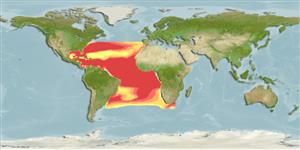>
Myctophiformes (Lanternfishes) >
Myctophidae (Lanternfishes) > Diaphinae
Etymology: Diaphus: Greek, dis, dia = through + Greek, physa, phyo = to beget, to have as offspring (Ref. 45335).
Environment: milieu / climate zone / depth range / distribution range
Écologie
marin bathypélagique; océanodrome (Ref. 51243); profondeur 40 - 750 m (Ref. 4479). Deep-water; 40°N - 40°S
Eastern Atlantic: Western Sahara to Mauritania (between 27°N and 16°N), probably absent in the Mauritanian Upwelling Region. Western Atlantic: USA to Argentina.
Length at first maturity / Taille / Poids / Âge
Maturity: Lm ?, range 7 - ? cm
Max length : 8.5 cm SL mâle / non sexé; (Ref. 4479)
Épines dorsales (Total): 0; Rayons mous dorsaux (Total): 12-14; Épines anales 0; Rayons mous anaux: 13
Oceanic and mesopelagic. Found between 375-750 m during the day; between 40-550 m at night (maximum abundance in 100 m depth). Sexually mature from about 7 cm (Ref. 4479).
Life cycle and mating behavior
Maturité | Reproduction | Frai | Œufs | Fécondité | Larves
Hulley, P.A., 1990. Myctophidae. p. 398-467. In J.C. Quero, J.C. Hureau, C. Karrer, A. Post and L. Saldanha (eds.) Check-list of the fishes of the eastern tropical Atlantic (CLOFETA). JNICT, Lisbon; SEI; Paris; and UNESCO, Paris. Vol. 1. (Ref. 4479)
Statut dans la liste rouge de l'IUCN (Ref. 130435)
Menace pour l'homme
Harmless
Utilisations par l'homme
Plus d'informations
Taille/ÂgeCroissanceLongueur-poidsLongueur-longueurFréquences de longueursMorphométrieMorphologieLarvesDynamique des populations larvairesRecrutementAbondanceBRUVS
RéférencesAquacultureProfil d'aquacultureSouchesGénétiqueElectrophoresesHéritabilitéPathologiesTraitementNutrientsMass conversion
CollaborateursImagesStamps, Coins Misc.SonsCiguateraVitesseType de nageSurface branchialeOtolithesCerveauxVision
Outils
Articles particuliers
Télécharger en XML
Sources Internet
Estimates based on models
Preferred temperature (Ref.
123201): 11.4 - 22.4, mean 16 °C (based on 187 cells).
Phylogenetic diversity index (Ref.
82804): PD
50 = 0.5000 [Uniqueness, from 0.5 = low to 2.0 = high].
Bayesian length-weight: a=0.00759 (0.00332 - 0.01733), b=3.02 (2.83 - 3.21), in cm total length, based on LWR estimates for this Genus-body shape (Ref.
93245).
Niveau trophique (Ref.
69278): 3.1 ±0.3 se; based on size and trophs of closest relatives
Résilience (Ref.
120179): Haut, temps minimum de doublement de population inférieur à 15 mois (Preliminary K or Fecundity.).
Fishing Vulnerability (Ref.
59153): Low vulnerability (10 of 100).
